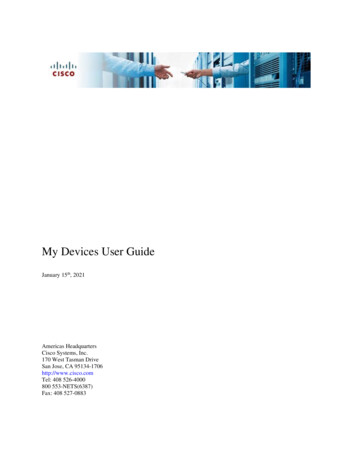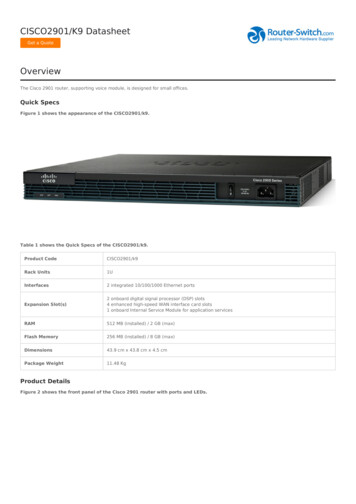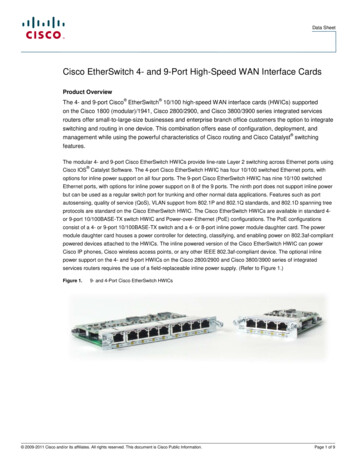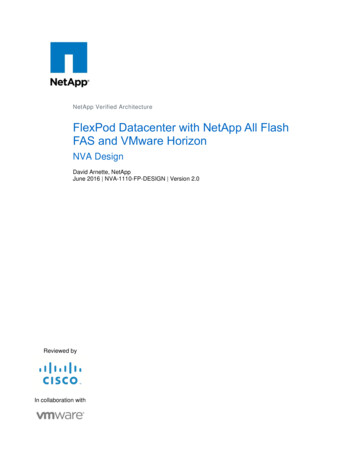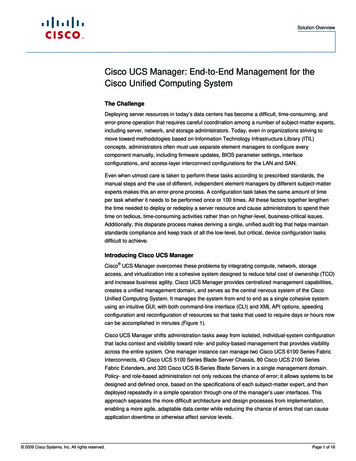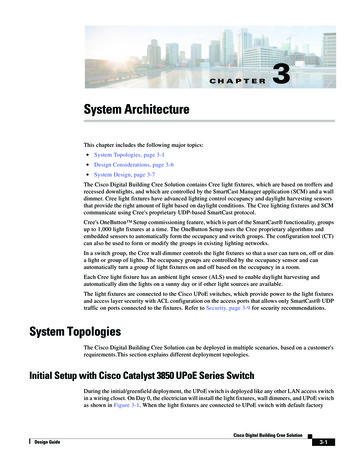
Transcription
CH A P T E R3System ArchitectureThis chapter includes the following major topics: System Topologies, page 3-1 Design Considerations, page 3-6 System Design, page 3-7The Cisco Digital Building Cree Solution contains Cree light fixtures, which are based on troffers andrecessed downlights, and which are controlled by the SmartCast Manager application (SCM) and a walldimmer. Cree light fixtures have advanced lighting control occupancy and daylight harvesting sensorsthat provide the right amount of light based on daylight conditions. The Cree lighting fixtures and SCMcommunicate using Cree's proprietary UDP-based SmartCast protocol.Cree's OneButton Setup commissioning feature, which is part of the SmartCast functionality, groupsup to 1,000 light fixtures at a time. The OneButton Setup uses the Cree proprietary algorithms andembedded sensors to automatically form the occupancy and switch groups. The configuration tool (CT)can also be used to form or modify the groups in existing lighting networks.In a switch group, the Cree wall dimmer controls the light fixtures so that a user can turn on, off or dima light or group of lights. The occupancy groups are controlled by the occupancy sensor and canautomatically turn a group of light fixtures on and off based on the occupancy in a room.Each Cree light fixture has an ambient light sensor (ALS) used to enable daylight harvesting andautomatically dim the lights on a sunny day or if other light sources are available.The light fixtures are connected to the Cisco UPoE switches, which provide power to the light fixturesand access layer security with ACL configuration on the access ports that allows only SmartCast UDPtraffic on ports connected to the fixtures. Refer to Security, page 3-9 for security recommendations.System TopologiesThe Cisco Digital Building Cree Solution can be deployed in multiple scenarios, based on a customer'srequirements.This section explains different deployment topologies.Initial Setup with Cisco Catalyst 3850 UPoE Series SwitchDuring the initial/greenfield deployment, the UPoE switch is deployed like any other LAN access switchin a wiring closet. On Day 0, the electrician will install the light fixtures, wall dimmers, and UPoE switchas shown in Figure 3-1. When the light fixtures are connected to UPoE switch with default factoryCisco Digital Building Cree SolutionDesign Guide3-1
Chapter 3System ArchitectureSystem Topologiesconfiguration, the light fixtures will come up with low brightness. The customer's technology team (IT)needs to be aware that the electrician cannot test the full brightness of the lighting fixtures until staticpower configuration is enabled on the UPoE switch ports connected to light fixtures.Figure 3-1Initial Setup with Cisco Catalyst 3850 UPoE Series SwitchInitial Setup with Cisco Catalyst 4500-E UPoE Series SwitchA scenario exists when a customer wants to deploy this solution based on a modular switch instead of astackable switch. The Cisco Catalyst 4500E UPoE switch serves this purpose, but it still requiresseparation between the light network and other shared services by having a separate VLAN for thelighting network. The initial/greenfield installation on a Day 0 remains the same on the Cisco Catalyst4500-E UPoE switch as described in Initial Setup with Cisco Catalyst 3850 UPoE Series Switch,page 3-1.Figure 3-2Initial Setup with Cisco Catalyst 4500-E UPoE Series SwitchCisco Digital Building Cree Solution Provisioning without UplinkWhen an access switch does not have an uplink connection and lighting network provisioning isrequired, a DHCP server needs to be configured on an access switch. Cree SCM is directly connected tothe switch, as shown in Figure 3-3. The SCM is required to configure, calibrate, monitor, and control thelight fixtures.Cisco Digital Building Cree Solution3-2Design Guide
Chapter 3System ArchitectureSystem TopologiesFigure 3-3Cisco Digital Building Cree Solution Provisioning with No UplinkAccessSwitchesWiring ClosetDHCPSCMLighting Network3767003850Large Scale DeploymentFigure 3-4 shows the architecture for large-scale deployment where the light fixtures are connected onCisco Catalyst 3850 stack and Cisco Catalyst 4500-E UPoE switches. The access switches are connectedto the Campus Network cloud, which is agnostic to the Cisco Digital Building Cree Solution. (Thedesign of Campus Network is out of scope of this document.) The critical services required to managethe UPoE switches, such as Syslog, TACACS , SNMP, and NTP reside in the data center, which isprotected by the firewall. All critical services run on a separate management VLAN, which spans fromthe data center to the UPoE switches. The firewall blocks all other traffic except the managementservices on the management VLAN.Figure 3-4Cisco Digital Building Cree Solution Large Scale DeploymentCisco Digital Building Cree SolutionDesign Guide3-3
Chapter 3System ArchitectureSystem TopologiesLogical Building DeploymentCree SCM can support 1000 light fixtures in a VLAN. A different broadcast domain/VLAN is requiredfor lighting networks containing over 1000 lighting fixtures. When more than 1000 lighting fixtures existin a building, multiple VLANs are required to logically divide a building into different broadcastdomains. The other requirement of Cree SCM is that each broadcast domain should have its own SCM.The same SCM can be used to connect to multiple VLANs, but it can manage one VLAN at a time. Thelocation of SCM is flexible; it can be connected to any switch in the network of the managed lightfixtures.Figure 3-5Cisco Digital Building Cree Solution with Different VLANsCisco Digital Building Cree Solution3-4Design Guide
Chapter 3System ArchitectureSystem TopologiesDeployment without Campus NetworkWhen the Cisco Digital Building Cree Solution is deployed in an environment without a Core/CampusNetwork, the access switches are directly connected to the data center via a firewall.Figure 3-6Cisco Digital Building Cree Solution No Campus NetworkSmall-Scale DeploymentWhen a lighting solution needs to deployed in a small store or office that contains 20 or fewer lightingfixtures, the Cisco Catalyst 3850 UPoE switch is sufficient with all the application services, such as SCMdirectly connected to the switch. The DHCP server is configured on the access switch.Figure 3-7Cisco Digital Building Cree Solution Small Scale DeploymentServer FarmPrime/SyslogSCMAccessSwitchesWiring ClosetDHCPLighting Network3766963850Cisco Digital Building Cree SolutionDesign Guide3-5
Chapter 3System ArchitectureDesign ConsiderationsDigital Building VLAN TopologyFigure 3-8 shows the logical view of a lighting network topology when more than 1,000 light fixturesexist. A building is logically broken down into multiple VLANs. A new VLAN is required when a VLANreaches the limit of 1,000 light fixtures. As mentioned previously, the location on SCM is flexible, aslong it is on the same VLAN of managed light fixtures, but each VLAN will require its own SCM.Figure 3-8Cisco Digital Building Cree Solution VLAN TopologyDesign ConsiderationsThe Cisco Digital Building Cree Solution should be deployed on a separate VLAN with a limit of 1,000lights fixtures per VLAN. A new VLAN is required to deploy more than 1,000 light fixtures that willrestrict the number of broadcast messages the light fixtures can process at a time. The performance ofthe light fixtures degrades when it processes more than 200 packets per seconds. A 200 packets persecond limit needs to be configured on the ports connected to the light fixtures. Each VLAN requiresSCM to configure, calibrate, and monitor the light fixtures. The single VLAN can have multiple SCMs,but only one SCM can be active at a time. The second SCM can't join the network unless an active SCMgrants the permission. A light fixture can only belong to one switch group and one occupancy group; itcannot be added to a second switch group and occupancy group.Cisco Digital Building Cree Solution3-6Design Guide
Chapter 3System ArchitectureSystem DesignSystem DesignThe Cisco Digital Building Cree Solution design is fully described in this section. Topics include: Lighting End Points SmartCast Manager Application Network Infrastructure Security Power Management High AvailabilityLighting FixturesCree SmartCast light fixtures are shipped from the factory with advanced lighting control sensors andembedded intelligence, which provides the right amount of light based on changing daylight conditions.The light fixtures share data with each other from their integrated occupancy and daylight sensors anduse their embedded intelligence, which is based on the Cree proprietary algorithm, to provide preciselythe right amount of light at the right time, based on changing conditions within the building. The lightfixture will automatically synchronize with rest of the group for state, mode, and settings on powercycle/reset and during rejoining the network.The different models of Cree fixtures require different amounts of power for the full brightness, whichis reflected in Table 3-1. The light fixtures will come to full brightness when static power is configuredon the UPoE switch.The Cree CR series light fixtures feature field-tunable color temperatures from 3000 Kelvin to 5000Kelvin. The Cree KR series is offered in two fixed color temperature variants at 3500 and 4000 Kelvin.For more details about the Cree lights, refer to the following link: artcast-technologySmartCast Manager ApplicationsThe SCM provides system control, monitoring, maintenance, firmware upgrade, and reporting for thelighting network. The SCM's OneButton Setup feature provides automatic discovery, calibration, andgrouping of the fixtures. The auto-grouping is formed by LightCasting, which lets fixtures know whatdevices are nearby. Once SCM does the OneButton commissioning, users can modify or customize theirgrouping and setting requirements very easily. The configuration tool can be used to form or modify thegroups in existing lighting networks.The OneButton setup process creates two types of groups: an occupancy group and a switch group. Occupancy groups form a set of fixtures that work in unison when someone enters the space andtriggers an occupancy event. The switch group forms a set of light fixtures controlled by wall dimmers.For both types of groups, light fixtures automatically turn off when vacancy is detected. A light fixturecan only reside in one switch group and one occupancy group.Cisco Digital Building Cree SolutionDesign Guide3-7
Chapter 3System ArchitectureSystem DesignThe SCM automatically detects a connected physical network interface that contains Cree light fixturesand provides a selection option if multiple network interfaces are found that have Cree light fixtures. TheSCM use SNMP discovery mechanism to gather the information of the switch ports on which the Creelight fixtures are connected and provide users access to control these ports.The SCM also displays the power savings and usage metrics for the network of commissioned lightfixtures. SCM is installed on a PC and then connects to the local lighting network. It provides thefollowing features: Power Visualization Savings: Bar Chart .csv File Export Features/Control of Power and OCC data storage Network Interface Selection Network Access Code Support (refer to the security section) Basic Fixture health monitoringNetwork InfrastructureAddressingThe Cree light fixtures supports IPv4 only. The DHCP server will dynamically assign IP addresses tolight fixtures.The DHCP server is configured on the aggregate switch to reduce the overhead of administering IPaddresses.However, in a scenario where the light fixtures are connected to an access switch that does not have anuplink connection, the DHCP needs to be configured on the access switch in order to provision the lightfixtures. After the commissioning phase, DCHP configuration can be migrated to the aggregate switchto reduce the overhead of administering and managing DHCP service on access switch. In that case, keepthe IP address pool the same during the migration.UPoE Switch FeaturesThe Cisco Catalyst 3850 and Cisco Catalyst4500-E series switches used in this solution support thefollowing general features:Cisco Catalyst 3850: Universal Power over Ethernet (UPoE) with 60W power per port in 1 rack unit (RU) form factor. Enterprise-class stackable switch. Dual redundant, modular power supplies and three modular fans providing redundancy. Power Stacking allows the power supplies to share the load across multiple systems in a stack. The Cisco Catalyst 3850 provides power in constant mode with two enhanced features for lightsolutions as described below:– Perpetual PoE—Perpetual PoE power to Power Devices (PD) during reloads. POE powerdelivered to PDs must be uninterrupted during a control plane reboot.– Fast PoE—The switch on a recovery after power failure provides power to the connected lightfixtures within 10 seconds, before even the IOS forwarding starts up. In this release, the fastPoE feature is only available for PoE. This release does not support the fast UPoE feature.Cisco Digital Building Cree Solution3-8Design Guide
Chapter 3System ArchitectureSystem DesignCisco Catalyst 4500-E: Universal Power over Ethernet (UPoE) switch. Provides up to 60W per port. 1 1 supervisor engine redundancy (4507R E and 4510R E). 1 1 power supply redundancy. In-Service Software Upgrade (ISSU) ensures continuous packet forwarding during supervisorengine switchover to help ensure high availability and uninterrupted power to light fixtures.Cabling Considerations CAT5E / CAT6 / CAT6A (AWG 23 - AWG 22)—A larger wire gauge allows more efficient powerdistribution which drives the 23 to an AWG recommendation. U/UTP CAT6, CAT5e cables (or better)—Can be used for connecting UPoE switch uplink ports tothe wiring closet access switches with a maximum length of 100m (according to IEEE 802.3).Table 3-1Lighting Fixture Power Requirement and Cable LengthLight FixturePower ConsumptionMaximum Cable Length from Light Fixture to POE SwitchCR2232 W100 metersKR628 W100 metersWall Dimmer1.5 W100 metersSecurityThe end-to-end security is broken down into three major parts, as shown in Figure 3-9: Endpoints security Network Infrastructure security Data Center securityFigure 3-9Cisco Digital Building Cree Solution End-to-End SecurityCREE EndpointsData CenterCisco Network DevicesISEASAPrimeUCSEnd-to-end security for device authentication, privacy, and data integrity Three Encryption keys: SCM-to-end point End point-to-end point SCM-to-endpoint forfirmware upgradeNetwork Authentication Code(NAC) VLAN traffic segregationSwitch port security features(Sticky MAC address)IPv4 security features (ARPRate Limit, Storm control,DHCP snooping, etc.)Traffic profiling based on ACLLimit 200 packets per second TACACS server for networkdevice authenticationSyslog messages fromswitchesSNMP traps from switchesFirewall only allowsmanagement traffic376698 Cisco Digital Building Cree SolutionDesign Guide3-9
Chapter 3System ArchitectureSystem DesignEndpoint SecurityCree EndpointsCree's SmartCast lighting system implements encrypted communications between the SCM and theendpoints (light fixtures and wall dimmers). The system uses the Elliptic-Curve Diffie-Hellman (ECDH)key exchange algorithm to establish a secure communication channel, which is then used to exchangesymmetric keys for subsequent communications.Three types of symmetric keys are used, depending on the type of communication: SCM to Endpoint (operating mode) SCM to Endpoint (firmware update mode) Endpoint to EndpointOn startup, the SCM checks the endpoint keys, and issues new keys to the endpoints if necessary.Endpoints store their keys in volatile or non-volatile (persistent) memory, depending upon the type ofkey.SmartCast Manager Application SecurityIt is strongly recommended that the SCM is deployed on a machine that is compliant to the IT policy ofthe customer, which should include the update policy of the standard (OS) components.The SCM uses UDP ports 55004 and 55007 for inbound and outbound communication with lights. It alsouses the SNMP protocol to discovery the directly-attached switches. The IT policy should allow theseports for proper communication. It is recommended to remove SCM from the network aftercommissioning the lights fixtures for security concerns. The caveat is customers will lose SCM powersaving and monitoring functionality.The NAC feature provides basic protection when users try to view/modify a lighting network. Lightfixtures internally maintain a network status flag, indicating if they belong to a protected network. Whileresponding to SCM's device discovery command, the light fixture will send information about this flag.SCM will save this information about every fixture in its local application cache. When a user tries toaccess any light fixture, SCM will first check its network status flag value. If it is true, the user will beasked to enter its NAC when accessing the light network. Only after successful verification of NAC willthe user be given access to that fixture.Network InfrastructureLighting Network VLANThe light fixtures use broadcast packets to advertise themselves on the lighting network. When the lightfixture powers up, it will go through a device initialization process. The fixture will broadcast a deviceinitialization packet on the lighting network. With this received packet, the SCM will detect that a newdevice has entered into the lighting network. The broadcast will hit every endpoint within a singlebroadcast domain. To protect other devices on the network, it is recommended to create a separate VLANfor the lighting network.Cisco Digital Building Cree Solution3-10Design Guide
Chapter 3System ArchitectureSystem DesignUPoE Switch SecurityThe security on the UPoE switch is provided by allowing only SmartCast protocol traffic on the portsconnected to the light fixtures, plus restrict only one light fixture per port.A port-based access control list (ACL) lets the switch automatically allow or block packets, based ontraffic policy, between the SCM and light fixtures, plus between light fixtures. The Cree light fixturescommunicate with each other over the UDP protocol. It is strongly recommended to create an ACL thatonly allows UDP traffic for 55004 and 55007 ports.The port security features restrict input to an interface by limiting and identifying MAC addresses of thefixture that are allowed to access the port. It is recommended to use a sticky MAC address that will allowa particular light fixture MAC address learned on a specific port.To protect against denial-of-service (DoS) attacks, restrict 200 packets per second on ports connected tolight fixtures.It is also recommended to implement the standard Layer 2 security features on switch ports, such as thefollowing: Storm control DHCP snooping BPDU Guard IPSource Guard Dynamic ARP Inspection ARP rate limitingData CenterThe management services reside in the data center on a separate management VLAN that is protected bythe firewall, which allows only management traffic from switches to the application servers in the datacenter. The secure access to the switches is provided via TACACS and SSH/HTTPS protocols. TheSyslog and SNMP traps are used to monitor and troubleshoot the switches. It will monitor the events,such as light fixture port security violations and port up/down status.Power ManagementThe UPoE switch provides the power to lighting fixtures depend on which type of lighting fixture isconnected to the port. Table 3-1 on page 3-9 shows that different lighting fixtures use different watts ofpower.The Cisco Catalyst 3850 UPoE switch has two power supplies per system, allowing the power load tobe split between them or provide redundant power supply. In addition, the stacking switch supportspower stacking, which allows the power supplies to share the load across multiple systems in a stack. Byconnecting the switches with power stack cables, the user can manage the power supplies of stackmembers as one large power supply, which provides power to all switches and to the powered devicesconnected to switch ports.The following are reasons for connecting individual switches into a power stack: If the power supply fails and enough spare power budget exists in the rest of the power stack, theswitch can continue to function. A defective power supply can be replaced without having to shut down all powered devices in thesystems.Cisco Digital Building Cree SolutionDesign Guide3-11
Chapter 3System ArchitectureSystem DesignThe following are two modes for power stacking: Power-Sharing Mode (the default)—All input power is available to be used for power loads. Thetotal available power in all switches in the power stack is treated as a single large power supply, withpower available to all switches and to all powered devices connected to UPoE ports. In this mode,the total available power is used for power budgeting decisions and no power is reserved toaccommodate power supply failures. If a power supply fails, powered devices and switches could beshut down (load shedding). Redundant Mode—The power from the largest power supply in the system is subtracted from thepower budget, which reduces the total available power, but provides backup power in case of apower-supply failure. Although less available power exists in the pool for switches and powereddevices to draw from, the possibility of having to shut down switches or powered devices in case ofa power failure or extreme power load is reduced.The Cisco Digital Building Cree Solution can be deployed with different types of light fixtures thatrequire different power consumption as shown in Table 3-1 on page 3-9. A light fixture uses a maximumpower of 40 watts. It is recommended to configure 24 ports switch with 1100/715 pair power suppliesand 48 ports switch with the 1100/1100 pairs power supplies. The switch allocates 880 watts of powerout of 1100 watts to the UPoE/PoE light fixtures.Select the mode based on the power available; for example, configure 48 port standalone switch inredundant mode when total power consumption of all light fixtures is less than 880 watts. Similarly,configure a unit of stacks in redundant mode when the total power available is more than the powerrequired by light fixtures. For example, if four units exist in a stack and each unit has dual 1100 wattsof power, the total number power supplies will be eight, out of which one power supply is reserved forredundant mode. The remaining seven power supplies will provide a total of 6160 watts of power (880per power supply time X seven power supplies). The reserve power supply will provide enough powerwhen a single power supplies fail.If the power consumption of all light fixtures is more than the allocated power budget, then configurepower stacking in the power-sharing mode. In this case, the switch also needs to be configured withpower priority, to allocate power to the lighting fixtures during the failover scenario. The high and lowpriority on the port determines the order in which devices are shut down, in case of a power lost and loadshedding. Configure different priority values, which will limit the number of lighting fixtures shut downat one time during a loss of power. For example, if multiple light fixtures exist in a room and configurefew light fixtures with high priority to avoid the darkness in a room; similarly provide the high priorityto the light fixtures installed at critical places.Even if one power supply is reserved on redundant mode, configuring port priority to that will providedual power failure protection. After one power supply failure, the redundant mode automatically changesitself to power-sharing mode, since no additional reserve power exists for another failure. In this case,having the port priority will provide power to high priority light fixtures.High AvailabilityIt is recommended to deploy the infrastructure in a redundant mode and follow the Campus Network bestpractices to minimize the service outage as much as possible even during the upgrade and migrationprocess.Typically, the network components at the access layer are considered non-critical assets. These assets,such as general lighting equipment and UPoE switches, do not require UPS backup.Cisco Digital Building Cree Solution3-12Design Guide
Chapter 3System ArchitectureSystem DesignWhen deploying the light fixtures and UPoE switches, an option is to connect the lights in an area to twoUPoE switches to minimize the outage or different units on stack switches. If one UPoE switch fails,half of the lights in one area can keep up, so the area won't become completely dark. This option mayincrease cabling complexity in the deployment, and potentially, increase the cable length and cost.Emergency lighting equipment, such as exit signs and emergency light fixtures, is required to always beavailable, and is not in scope of this phase of architect design.The Cisco Catalyst 3850 UPoE switches have dual power supply for redundancy and also support thepower stacking. This is where the number of power supplies from different switches in a stack act as onelarge power supply, which provides power to all switches and to the powered devices connected to switchports. Additionally, a Cisco Catalyst 3850 UPoE switch provides high availability through enhanced PoEfeatures such as Perpetual PoE and Fast PoE.The Cisco Catalyst 4500-E UPoE switch provides several features to minimize planned and unplannedoutages. It has two power supply bays that support two of the same supplies in a redundant mode or ina combined power-sharing mode. The In-Service Software Upgrade (ISSU) provides the means toupgrade or, if needed, downgrade the Cisco IOS Software in a redundant Cisco Catalyst 4500 E-Seriessystem, without incurring a service outage.Cisco Digital Building Cree SolutionDesign Guide3-13
for lighting networks containing over 1000 lighting fixtures. When more than 1000 lighting fixtures exist . The SCM provides system control, monitoring, maintenance, firmware upgrade, and reporting for the . † Occupancy groups form a set of fixtures that work in






